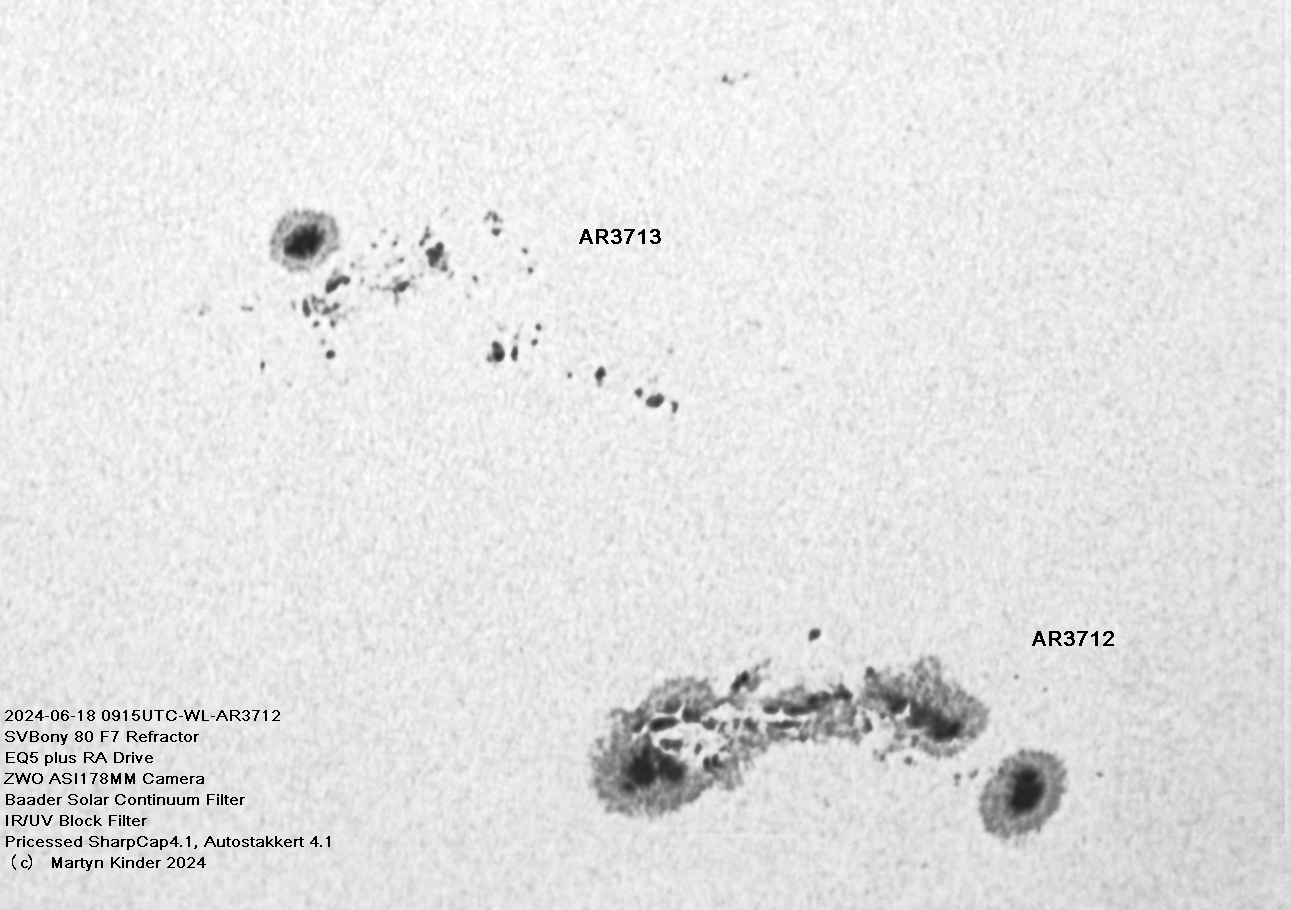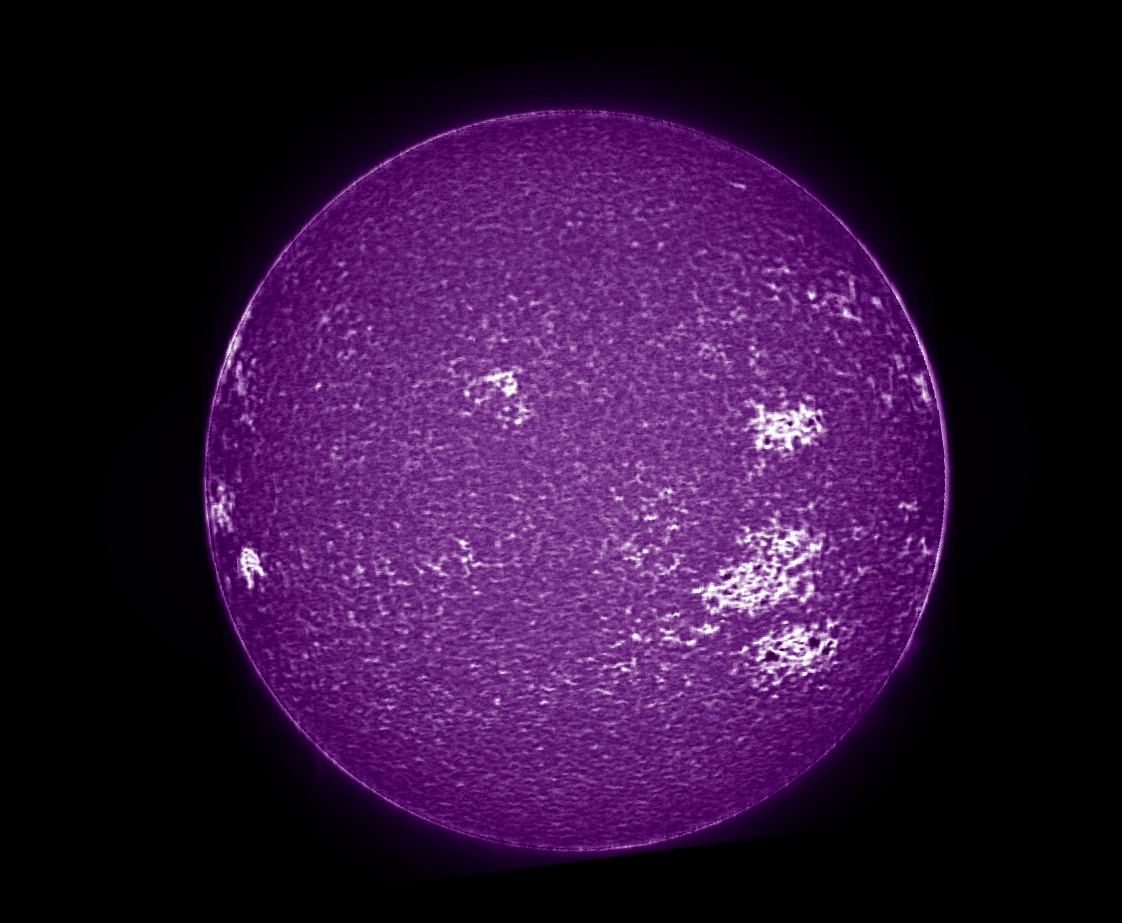Latest Posts
Sun - 20240618
Seeing hasn't been too good in the past 3 or 4 weeks. I thought a holiday trip to Cromer on the NE coast of Norfolk for a week may produce better seeing but I was mistaken.
However, it was good to watch AR3712 develop, a very complex sunspot group, very unlike AR3713 above which is more typical of large sunspot group.
This is a White Light Image of the photosphere, using a solar continuum filter (green) to enhance contrast. Compare the quality with the WL images on 20240519

500 frames with the best 30% selected produced a very iffy image - even after post capture processing.
20240620 - Solex
I am still trying to get to grips with my Sol'ex and still making some fairly fundamental mistakes. Focussing, particularly at the UV end of the spectrum is very tricky. The image is quite dim on the screen and to maintain the 10mS maximum exposure time, a certain amount of camera gain is required. This adds noise which can compound the focussing problems.
Nonetheless, a couple of nice images while on holiday in Cromer.

The Sun in Hydrogen Alpha (Ha). A little bit underexposed and the spicules are not as clear as they could be. A very large (long) filament clearly visible. Sunspots can be seen through the chromosphere on the surface of the photosphere,

This image in Calcium H at the UV end of the spectrum. The active regions are much more clearly defined, spicules (the large granulation) are visible and the larger sunspots are also visible. AR 3712 is at the lower right with AR 3713 just above. AR 3716 is above and slightly to the right again. West (astronomical convention) is to the right and North upwards.
Compare with the WL image of the photosphere here: https://www.spaceweather.com/images2024/20jun24/hmi1898.gif

This image is in Calcium K, further into the UV end of the spectrum. Apart from the fact I inadvertently cropped the bottom of the image, this is very similar to the Calcium H image above. Calcium K accentuates the spicules and active regions even more, look at the NW and NE sections of the hemisphere where the difference is clearer to see. The downside is that it is more difficult to focus and position the image on the PC screen.
2024-06-20 10:05 - 010:50 UTC
60mm F4 Refractor stopped down to 36mm
ND9 filter to reduce light and heat intensity
Sol'ex spectroheliograph
EQ5 plus RA Drive
ZWO ASI178MM Camera
Processed SharpCap4.1, jSolex
(c) Martyn Kinder 2024
20240621 - Solex
Although I tried to image in Ha and CaH/K this morning, however, only the Ha images were successful. The Ca images were rendered useless as focus was not sharp enough and the images also became slightly distorted for some unknown reason. Need to concentrate a bit more prepping for imaging.

This is not a bad image all things considered. Active regions are clearly defined and that huge filament and others are very clear. Not much in the way of prominences though.
2024-06-21 10:08UTC
60mm F4 Refractor stopped down to 36mm
ND9 filter to reduce light and heat intensity
Sol'ex spectroheliograph
EQ5 plus RA Drive
ZWO ASI178MM Camera
Processed SharpCap4.1, jSolex
(c) Martyn Kinder 2024
20240623 - Solex
Almost the last day of my hols and the last day of imaging.
A better day than the previous in terms of seeing and my competence.
First, Ha
Not as sharp as it could be but the prominences show up remarkably well

Calcium K - quite pleased with this, it appears to be sharp and there is very good definition.

and finally, Hydrogen Beta

I think that the bands occur when the line is selected using SharpCap. Broadly, the line is selected by drawing a box around the spectral line. I think that my problem here is that the box is too deep and that is causing the banding effect. I'll need to experiment further.
2024-06-23 09:20 - 09:50 UTC
60mm F4 Refractor stppoed down to 36mm
ND9 filter to reduce light and heat intensity
Sol'ex spectroheliograph
EQ5 plus RA Drive
ZWO ASI178MM Camera
Processed SharpCap4.1, jSolex
(c) Martyn Kinder 2024
Page 2 of 2
